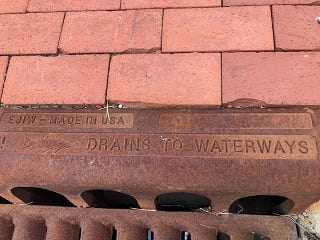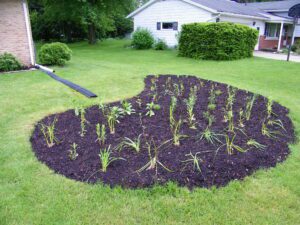When rain falls on natural areas it is slowed down, filtered by soil and plants, and allowed to gradually soak back into the ground. When rain falls on impervious (hard) surfaces, such as rooftops, roads, parking lots and driveways, it does not soak into the ground and storm water runoff is created. This runoff picks up pollution like fertilizer, pesticides, sediment, motor oil, trash and pet waste. Some of this runoff goes to the treatment plant but much of it goes into storm drains that flow directly into Lake Maxinkuckee.

Culver Zoning Ordinance regulates the maximum allowable impervious surface based on zoning district. The greater the percentage of impervious surface, the more stormwater runoff is created.
You can help reduce this runoff, and thereby help the water quality of the lake, by reducing the impervious surfaces on your property. However, many of these surfaces are unavoidable and impractical to replace with more environmentally friendly solutions. A relatively easy, inexpensive and beautiful alternative is a raingarden.
www.epa.gov website says:
“A raingarden is a depressed area in the landscape that collects rain water from a roof, driveway or street and allows it to soak into the ground. Planted with grasses and flowering perennials, rain gardens can be a cost effective and beautiful way to reduce runoff from your property. Raingardens can also help filter out pollutants in runoff and provide food and shelter for butterflies, song birds and other wildlife.”
By capturing runoff and letting it soak into the ground, raingardens also help recharge stores of groundwater in aquifers.

With all this going for them, you would think there would be a raingarden on every property! Want to know more? Come to Native Landscaping 101 at the Culver-Union Township Public Library on Tuesday, July 14th at 6:00 pm. Jodie Overmyer from the Marshall County Soil & Water Conservation District, and I will be talking about native plants, invasive species and raingardens.
You can also visit the Environmental Protection Agency Soak Up the Rain website for more ways YOU can reduce stormwater runoff,

Hi, I’m Debbie Palmer. I received a BS in Horticulture from Purdue University. Here at LMEF, I am responsible for outreach presentations, monitoring the lake and it’s wetlands, project manager for restoration and research projects, and act as a community resource for all things related to the well-being of Lake Maxinkuckee and its surrounding watershed. I completed Indiana Watershed Leadership Academy, volunteer with the Indiana Clean Lakes Program, Hoosier River Watch and Marshall County Lakes and Waters and serve as a Board Member for Indiana Lakes Management Society.


Love this post, Debbie! Thanks for sharing the insight!